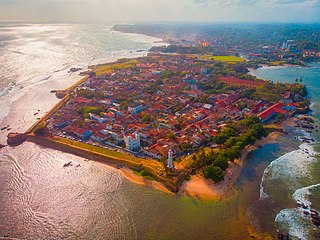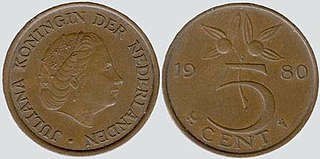Related Research Articles

The United East India Company, commonly known as the Dutch East India Company, was a chartered trading company and one of the first joint-stock companies in the world. Established on 20 March 1602 by the States General of the Netherlands amalgamating existing companies, it was granted a 21-year monopoly to carry out trade activities in Asia. Shares in the company could be purchased by any citizen of the United Provinces and subsequently bought and sold in open-air secondary markets. The company possessed quasi-governmental powers, including the ability to wage war, imprison and execute convicts, negotiate treaties, strike its own coins, and establish colonies. Also, because it traded across multiple colonies and countries from both the East and the West, the VOC is sometimes considered to have been the world's first multinational corporation.

Galle is a major city in Sri Lanka, situated on the southwestern tip, 119 km (74 mi) from Colombo. Galle is the provincial capital and largest city of Southern Province, Sri Lanka and is the capital of Galle District.

The Sri Lankan Rupee is the currency of Sri Lanka. It is subdivided into 100 cents, but cents are rarely seen in circulation due to its low value. It is issued by the Central Bank of Sri Lanka. The abbreviation Re (singular) and Rs (plural) is generally used, the World Bank suggests SL Rs as a fully disambiguating abbreviation for distinction from other currencies named "rupee".
Burgher people, also known simply as Burghers, are a small Eurasian ethnic group in Sri Lanka descended from Portuguese, Dutch, British and other Europeans who settled in Ceylon. The Portuguese and Dutch had held some of the maritime provinces of the island for centuries before the advent of the British Empire. Burgher people are often referred to as belonging to one of two sub-groups, either Dutch Burghers or Portuguese Burghers, though both are of mixed descent.

Gustaaf Willem, Baron van Imhoff was a Dutch colonial administrator for the Dutch East India Company (VOC). He served as Governor of Ceylon from 1736 to 1740 and as Governor-General of the Dutch East Indies from 1743 until his death in 1750 at Istana Cipanas.

The stuiver was a coin used in the Netherlands, worth 1⁄20 of a guilder. It was also minted on the Lower Rhine region and the Dutch colonies. The word can still refer to the 5 euro cent coin, which has almost exactly the same diameter and colour despite being over twice the value of the older coin.

The rijksdaalder was a Dutch coin first issued by the Republic of the Seven United Netherlands in the late 16th century during the Dutch Revolt which featured an armored half bust of William the Silent. It was the Dutch counterpart of the Reichsthaler of the Holy Roman Empire but weighed slightly less, at 29.03 g of 0.885 fine silver, reduced to 0.875 fine by the 17th century. Friesland, Gelderland, Holland, Kampen, Overijssel, Utrecht, West Friesland, Zeeland, and Zwolle minted armored half bust rijksdaalders until the end of the 17th century.

The rixdollar was the currency of British Ceylon until 1828. It was subdivided into 48 stivers, each of 4 duit. Units called the fanam and larin were also used, worth 4 and 9½ stiver, respectively. The currency derived from the Dutch rijksdaalder and stuiver, although the rijksdaalder was worth 50 stuiver.

Sri Lankan place name etymology is characterized by the linguistic and ethnic diversity of the island of Sri Lanka through the ages and the position of the country in the centre of ancient and medieval sea trade routes. While typical Sri Lankan placenames of Sinhalese origin vastly dominate, toponyms which stem from Tamil, Dutch, English, Portuguese and Arabic also exist. In the past, the many composite or hybrid place names and the juxtaposition of Sinhala and Tamil placenames reflected the coexistence of people of both language groups. Today, however, toponyms and their etymologies are a source of heated political debate in the country as part of the political struggles between the majority Sinhalese and minority Sri Lankan Tamils.

Dutch Ceylon was a governorate established in present-day Sri Lanka by the Dutch East India Company. Although the Dutch managed to capture most of the coastal areas in Sri Lanka, they were never able to control the Kingdom of Kandy located in the interior of the island. Dutch Ceylon existed from 1640 until 1796.

HMS Suffolk was a 74-gun third-rate ship of the line of the Royal Navy, launched on 22 February 1765 at Rotherhithe. She was designed by William Bateley, based on the principles of his earlier HMS Fame, and was the only ship built to her draught.

Green Point is an affluent suburb on the Atlantic Seaboard of Cape Town, South Africa located to the north west of the central business district. It is home to Cape Town Stadium, a major sporting venue that was built for the 2010 FIFA World Cup. Sea Point promenade runs through the suburb, connecting it to Three Anchor Bay and Sea Point, a popular Jewish neighbourhood. Somerset Road forms the main thoroughfare lined by restaurants, cafés, delis, boutiques and nightclubs.

Dutch colonial architecture refers to the various style of Dutch architecture built across the Dutch Empire. Though most of the buildings were designed by Dutch architects and dictated by Western architectural styles, even the most ardent style-purists among architects could not escape the forces of context and culture. Dutch colonial architecture often is a result of climatological adaptations or the use of local building materials - and more importantly, the rich and diverse cultural contexts. In this hybridity lies the quality of these buildings. Architecture shows that the strict racial taxonomy of a colonial system could not be maintained.
Jacob Sørensen Severin was a Danish merchant who held a trade monopoly on Greenland from 1733 to 1749.

The Dutch Cape Colony was a Dutch United East India Company (VOC) colony in Southern Africa, centered on the Cape of Good Hope, from where it derived its name. The original colony and the successive states that the colony was incorporated into occupied much of modern South Africa. Between 1652 and 1691, it was a Commandment, and between 1691 and 1795, a Governorate of the VOC. Jan van Riebeeck established the colony as a re-supply and layover port for vessels of the VOC trading with Asia. The Cape came under VOC rule from 1652 to 1795 and from 1803 to 1806 was ruled by the Batavian Republic. Much to the dismay of the shareholders of the VOC, who focused primarily on making profits from the Asian trade, the colony rapidly expanded into a settler colony in the years after its founding.

Count Charles-Daniel de Meuron was the founder of a Swiss mercenary regiment, Regiment de Meuron, which was employed in the service of the Dutch East India Company in Cape Town and Ceylon.

Slavery in South Africa existed from 1653 in the Dutch Cape Colony until the abolition of slavery in the British Cape Colony on 1 January 1834. This followed the British banning the trade of slaves between colonies in 1807, with their emancipation by 1834. Beyond legal abolition, slavery continued in the Transvaal though a system of inboekstelsel.
Cornelis Jan Simonsz was a Governor of Dutch Ceylon from 11 May 1703 until 22 November 1707.

South Africa – Sri Lanka relations refers to the current and historical relations between South Africa and Sri Lanka. The Government of South Africa established its resident diplomatic mission in Colombo in September 2007. HE Sirisena Amarasekara is the current Sri Lankan High Commissioner to South Africa while HE Ms RP Marks is the current South African High Commissioner to Sri Lanka. Both countries are members of the Commonwealth of Nations.